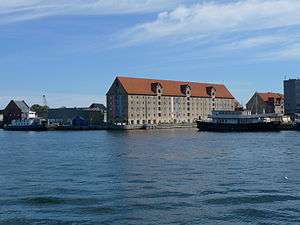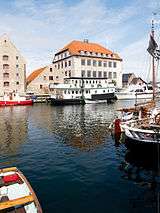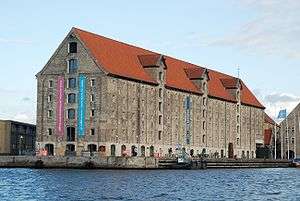Grønlandske Handels Plads

(Kongelige) Grønlandske Handels Plads ("(Royal) Greenland Dock") is a waterfront area at the end of Strandgade in the northwestern corner of the Christianshavn neighbourhood of Copenhagen, Denmark. The area is bounded by the Trangraven canal to the north, Christianshavn Canal to the east, Krøyers Plads to the south and the main harbor to the west. The waterfront is also known as Nordatlantens Brygge (English: North Atlantic Quay). For more than 200 years, i was a hub for Danish trade on Greenland, Iceland and the Faroe Islands. The most notable building is North Atlantic House, am 18th century warehouse now used as a cultural centre for the North Atlantic area.
The threeway Trangravsbroen bridge connects Grønlandske Handelsplads to Holmen, Copenhagen, Holmen to the north of Trangraven and Islands Plads on the other side of Christianshavn Canal while the Inderhavnsbroen bridge connects the area to Nyhavn on the other side of the harbor.
History
.jpg)
Grønlandske Handels Plads is part of the area that Andreas Bjørn reclaimed in the 1730s for his shipyard which became known as Bjørnholm ("Bjørn's Isle"). In 1747, Bjørn sold the northern part of the site to Det almindelige Handelsselskab ("The General Trading Company") which in 1750 obtained a monopoly on trade on Greenland. From 1763 the company was also responsible for trade on Iceland, Finmarken and the Faroe Islands. Master builder Johan Christian Conradi was commissioned to build a large warehouse for the company which was completed in 1767. Conradi had led the construction of the Eigtved Warehouse for the Danish Asia Company at Asiatisk Plads in 1750 and later also been involved in the construction of several other large warehouses in Christianshavn either as a builder or architect. The new warehouse was initially known as the Icelandic Warehouse and later as the Greenlandic Warehouse.[1]
.jpg)
In 1774, Det Almindelige Handelsselskab was dissolved and the Royal Greenland Trading Department came under direct control of the state. The southern part of Grønlandske Handels Plads was sold to Hans Krøyer in 1802 and became known as Krøyers Plads. Krøyers Plads was reacquired by Royal Greenland in 1938.ref name=Fredning/> The company sold the area to the Danish state in 1975 but continued to use the buildings until 1980. The buildings were left empty for a couple of years but then used by first the Danish Customs and Taxes Authority and then Danish Polar Center and University of Copenhagen's Arctic Institute and Institute of Eskimology.[2]
Public art
On the quayside next to Danish Polar Center stands Eva Sørensen's granite schlpture Pearl Anglais. It is three and a half metre high, weights 13 tons, and consists of five volumes in a Cairn-like composition.[3]
Notable buildings


Conradi's warehouse is now known as North Atlantic House. The building contains the representations of Freenland, Iceland and the Faroe Islands as well as a cultural centre dedicated to the North Atlantic area. Restaurant Noma is also based in the building.
A line of four smaller buildings us located on the east side of Strandgade, facing Christianshavn Canal. Danish Polar Center occupies the building at Strandgade 102. Then follows the so-called Skindpakhuset ("The Hide Warehouse", No. 104), a listed warehouse from 1906. Strandgade 106, which is variously known as Det Brede Pakhus ("The Wide Warehouse"( or Store Bakkehus, is from 1781 and also listed. No. 108 is a residential building located on the corner of Christianshavn Canal and Trangraven Canal.[1]
Redevelopment
Grønlandske Handelsplads has an area of approximately 6m000 square metres.[4] An architectural competition for the design of a new masterplan for Grønlandske Handelsplads, Christiansholm, Arsenaløen and Dokøen was launched in 2015.[5]
References
- 1 2 "Sag: Grønlandske Handels Plads". Kulturstyrelsen. Retrieved 9 October 2015.
- ↑ "Nordatlanten skal samles i ét hus". Jyllands-Posten. Retrieved 9 October 2015.
- ↑ "Øjet i stenen". Berlingske. Retrieved 9 October 2015.
- ↑ "Grønlandske HandelspladsPlads". Christianshavns Lokaludvalg. Retrieved 9 October 2015.
- ↑ "Arkitektkonkurrence om Papirøen, Arsenaløen, Dokøen og Grønlandske Handels Plads". Byens Ejendomme. Retrieved 9 October 2015.